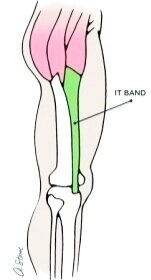Runner’s knee is also referred to as iliotibial band friction syndrome. Your iliotibial band (IT Band) is a thick, strap-like form of connective tissue that extends (similar to a tendon) from the top of your hip & TFL muscle & inserts into the outside of your knee joint. While not responsible for prime movement when walking, running or cycling it is prone to repetitive strain issues & injuries. With strained repetition, the lower attachment at the outside of the knee can rub or rather, friction against the boney aspects of the knee causing pain that may be itchy, achy, pinchy or sharp.
How we might treat?
As a massage therapist or a Chiropractor, we will assess the global architecture of the body, especially the lower body from the lower back & hips to the knees & feet. We assess for mechanical imbalances in movement patterns to help find the source of the problem and release the related tension and pain pattern.
WHAT CAN YOU DO TO HEAL YOUR OWN IT BAND?
Pain at the knee? ICE ICE ICE! You can ice for 10-15 minutes until you feel a ‘numbing’ sensation. Ice is nature’s anesthetic and can help reduce inflammation as it relates to joint pain. Ice protocol follows the acronym CBAN, meaning we want to feel the following sensations; cold, burny, achy & then numb.
Invest in & get fitted for proper footwear! For running, you should aim to size up from your regular size & for any type of sneaker you want to make sure the front part of your foot (the toe box) feels spacious enough for your toes to relax. Make sure your daily footwear is sensibly supporting your body well.
IT band issues may correlate with muscle or boney imbalances of the body. They can also be contributing to or attributed with biomechanical issues related to movement. Improving core strength helps with healing as well as the prevention of injury & is always a good return on investment. Movement therapies such as yoga or pilates offers physical expression that contributes to mind-body awareness and a balance of supporting the body in strengthening & lengthening goals. Often, the best outcomes in body work such as massage or chiropractic is intimately dependant on the client actively participating in these forms of self care.
2 cups of Epsom salts + 12 minute bath = restorative epsom salts bath. Studies show that increasing the levels of magnesium in soft tissue (aka muscle or fascia) helps reduce lactic acid & soft tissue tension. Balancing your magnesium levels can help with tension, headaches, muscle cramps and spasms.
to roll or not to roll...diving into the foam rolling debate
Foam Rolling: is a form of self-massage that’s very effective for relaxing the connective tissue and muscles surrounding the leg & thigh bones. There is debate as to whether foam rolling the IT Band is significant. Technically, the IT Band doesn’t have much of a blood supply, but the muscles that surround it and the TFL that’s its’ attached to, do ~ so you have a better chance of affecting tissue health surrounding the ITB with self massage techniques like foam rolling.
Addressing the IT band can be helpful for everyone. Helping release it’s state of contracture will help your knees and hips feel better as well as encourage better muscle firing and balance between your hamstrings and quadriceps.
While self-care is extremely important, if your sore spots persist, it may be wise to seek advice and treatment from a massage therapist, chiropractor or athletic trainer.








